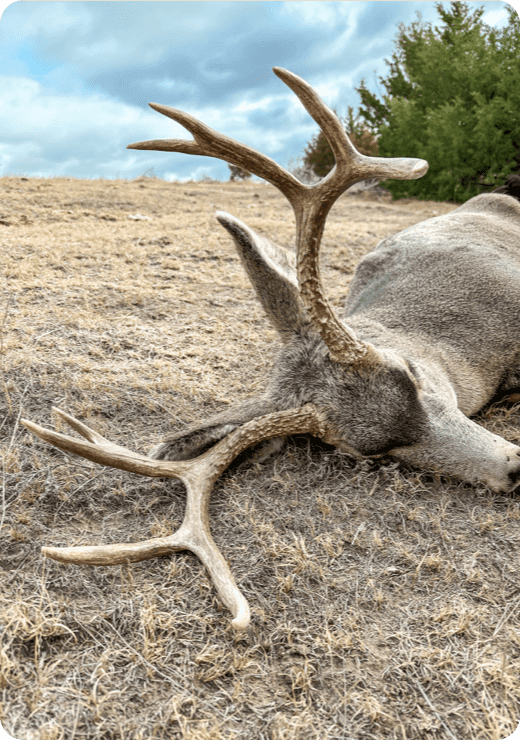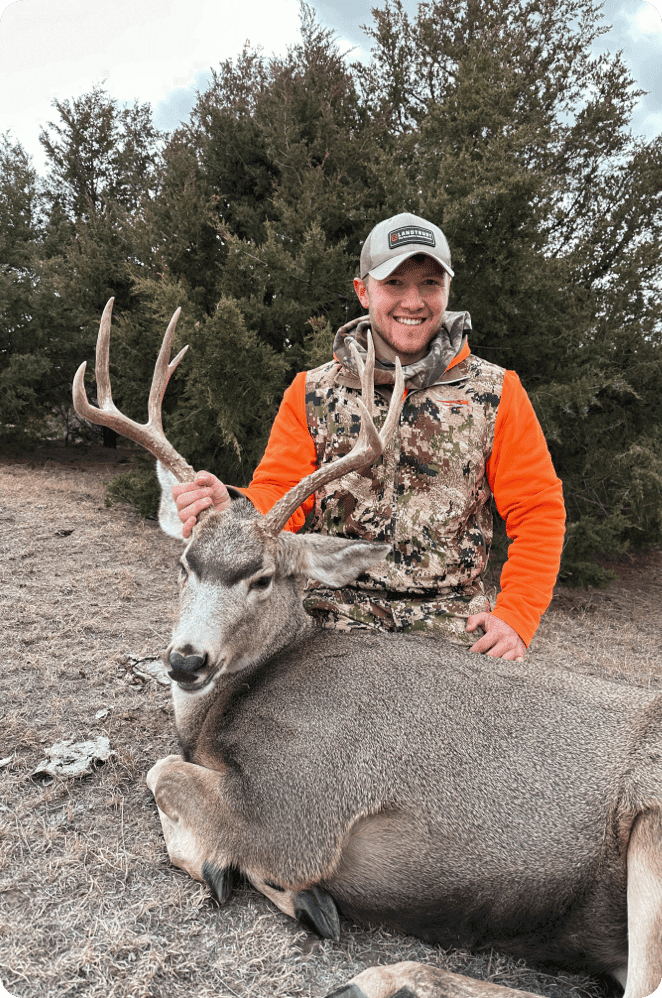Book your next Nebraska Mule Deer hunt with LandTrust, the best way to hunt private land.
Find your next Nebraska Mule Deer hunt by Unit.
Unit Frenchman
This expansive unit is located in the southwestern corner of the state and hosts a robust deer population. While public land is somewhat limited, hunting on private property greatly enhances the chances of a successful hunt. Mule deer are present in healthy numbers throughout the area, and Dundy County, situated in the far southwest corner of the unit, has produced several record-book entries in recent years.
Unit Missouri
The Missouri unit includes Knox County and parts of Antelope, Boyd, Cedar, Dakota, Dixon, Holt, and Pierce counties. Nebraska residents and non-residents can purchase a deer tag over the counter.
Unit Sandhills
This unit is located in the north-central part of the state and boasts a robust deer population along with diverse terrain. While the northwestern edge includes some agricultural activity, most of the area consists of undeveloped lands resembling sand hills. Additionally, lakes and ponds are scattered throughout the landscape, creating marshy conditions nearby.
Unit Upper Platte
Situated along the borders of Wyoming and Colorado, this unit boasts impressive deer populations and provides excellent hunting opportunities. The majority of the area consists of private agricultural land, which can pose access challenges but also contributes to strong herd health and antler development. It may be beneficial to seek permission to hunt on private property.
Unit Calamus West
This unit is located in the central part of the state and boasts a strong deer population along with diverse terrain. Compared to many other units, public land is more accessible, but hunters should still conduct thorough research to ensure a successful outing. Mule deer are present in good numbers, particularly in the open prairie, but they can also be found near agricultural areas. Gaining access to private land may be the biggest challenge for hunters; however, hunting on these properties greatly enhances the likelihood of success.
Unit Plains
Situated on the western side of the state, adjacent to Wyoming, this large unit has limited public land access. However, hunters who dedicate time to thorough e-scouting and exploration may discover valuable hunting opportunities. The terrain varies from rugged landscapes to more accessible areas, offering a diverse hunting experience that caters to those looking for both challenges and potential successes. Mule deer are present in healthy numbers throughout the unit. Hunters can engage in traditional spot-and-stalk methods on the prairie as well as pursue herds near agricultural fields.
Unit Buffalo
Located in the south-central part of the state, this unit is divided by the well-known Platte River. It features healthy deer populations, offering hunters excellent opportunities for pursuing bucks. The private lands surrounding the river primarily consist of agricultural fields, while much of the northern half is characterized by natural rolling grasslands. Securing access to private land is highly recommended in this unit.
Unit Pine Ridge
Situated in the northwestern corner of the state, adjacent to South Dakota and Wyoming, this large unit is recognized for its extensive public access. It encompasses a variety of habitats that sustain healthy populations of both Whitetail and Mule Deer. The terrain features a mix of landscapes, from open plains to forested areas, making it a popular choice for deer hunters looking for both accessibility and quality hunting experiences. Predominantly characterized by rolling prairie, the area also includes agricultural zones, but much of it remains untouched, offering excellent hunting opportunities.
Unit Platte
This expansive unit is located on the western side of the state and supports a robust deer population. It is effectively divided by Interstate 80, with rangeland dominating the northern section and agricultural fields in the south. While the majority of the area consists of private land, which can pose access challenges, it also contributes to strong herd health and impressive antler growth.
Unit Keya Paha
This unit is located in the north-central part of the state, bordering South Dakota. It features healthy deer populations, although much of the area consists of private lands, many of which are undeveloped. Public land access is limited, but careful research into access options can help hunters achieve success. Mule deer are present in smaller numbers, primarily in the open prairie, but they can also be found near various agricultural zones.
Unit Loup West
This unit is situated in the central part of the state and offers outstanding deer habitat. Public land options are quite limited, with only a few accessible properties available. Hunters who rely solely on public land may find few opportunities here. Private lands provide the best chances for success, featuring various terrain types suitable for hunters of all experience levels and goals. Mule deer are present in healthy numbers, mainly in the western half of the unit, where open prairie and agricultural areas abound.
Unit Loup East
The Loup East unit includes Howard and Nance counties and parts of Boone, Buffalo, Garfield, Greeley, Hall, Merrick, Platte, Sherman, Valley, and Wheeler counties. Nebraska residents and non-residents can purchase a deer tag over the counter.
Discover More
- Nebraska Whitetail Hunting Units
- Nebraska Grouse Hunting Units
- Nebraska Pheasant Hunting Units
- Nebraska Turkey Hunting Units
- Nebraska Dove Hunting Units
- Nebraska Quail Hunting Units
- Nebraska Coyote Hunting Units
- Nebraska Waterfowl Hunting Units
- Nebraska Duck Hunting Units
- Nebraska Elk Hunting Units
- Nebraska Other Hunting Units
- Nebraska Antelope Hunting Units
- Nebraska Prarie Dog Hunting Units
- Nebraska Mule Deer Unit Frenchman
- Nebraska Mule Deer Unit Calamus West
- Nebraska Mule Deer Unit Sandhills
- Nebraska Mule Deer Unit Calamus East
- Nebraska Mule Deer Unit Missouri
- Nebraska Mule Deer Unit Plains
- Nebraska Mule Deer Unit Buffalo
- Nebraska Mule Deer Unit Keya Paha
- Nebraska Mule Deer Unit Pine Ridge
- Nebraska Mule Deer Unit Platte
- Nebraska Mule Deer Unit Upper Platte
- Nebraska Mule Deer Unit Loup East
- Nebraska Mule Deer Unit Loup West

